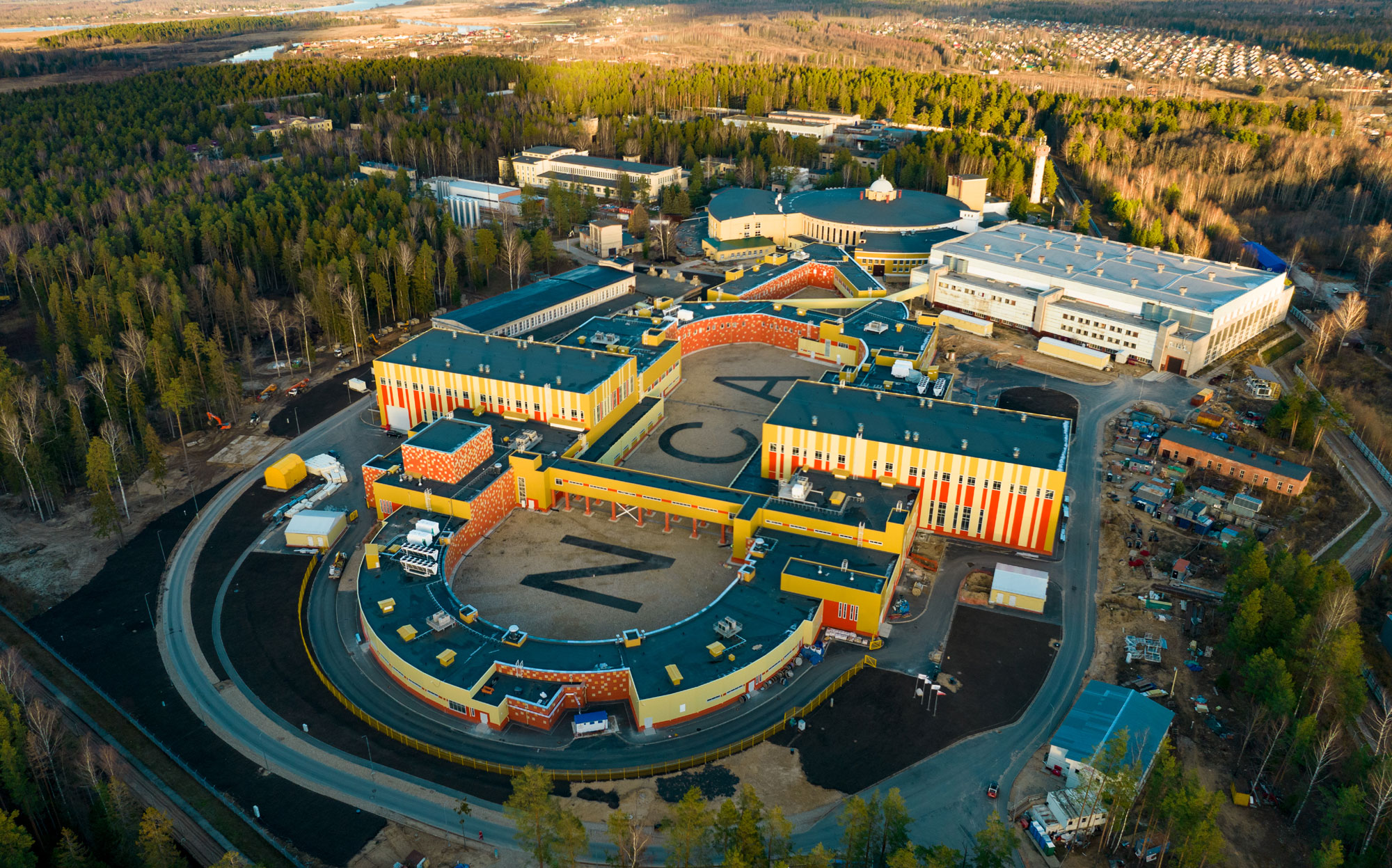NICA will help make space flights safer
Media, 05 April 2023
During the fourth commissioning run at the NICA Accelerator Complex, the first applied studies on high-energy xenon ion beams extracted from the Nuclotron were carried out. A long-standing partner of JINR, the Institute of Biomedical Problems of the Russian Academy of Sciences, the leading organization of the Russian Federation for the safety of manned space flights was among the first institutes that were able to use ARIADNA (Applied Research Infrastructure for Advance Development at NICA fAcility). The researchers of the IBMP RAS examined the radiation resistance of two new materials for the protection of the cabins of Russian cosmonauts at the International Space Station (ISS). The seeds of plants having practical importance from the point of view of cultivation in space flights were irradiated during the commissioning run.
Head of the Radiation Safety of Manned Space Flights Department of the IBMP RAS Vyacheslav Shurshakov and Deputy Head of Unit for Scientific and Methodological Research and Innovation of the VBLHEP JINR Oleg Belov spoke about the start of works at the NICA Complex related to the safety of manned space flights in an interview with the JINR Press Office.
“We were waiting for the beginning of this run impatiently, when particles with “our” energies, i.e. up to several GeV per nucleon will appear at the NICA Complex. They allow simulating the cosmic radiation, receiving the flow of the same particles, the beams of carbon, nitrogen, oxygen, iron, xenon, etc. For us, NICA is a kind of simulator of cosmic radiation, which also affects the crews of spacecraft,” Head of the Radiation Safety of Manned Space Flights Department of the IBMP RAS Vyacheslav Shurshakov commented. The accelerators of heavy charged particles are the only way to approximately reconstruct the spectra of cosmic radiation on Earth. In this regard, the NICA Complex has a unique set of physical parameters.
Irradiation of composite materials
At different heights of the Earth’s orbit, the radiation environment is different. For example, the radiation level at the International Space Station is 250 times higher than the Earth’s background radiation. Even in quiet conditions, without going into outer space, in days when there are no solar flares, the astronauts are exposed to high levels of radiation.
The Radiation Safety of Manned Space Flights Department of the Russian Academy of Sciences has found out that in recent years the ISS cabins of astronauts, where they spend most of their time, were poorly protected from radiation compared to other rooms. The cabins are designed so that they take up most of the station’s space. As a result, the radiation dose received in the cabins of astronauts is 20 – 30% more than in other places of the station. About ten years ago, an original solution was found in order to improve this situation.
The scientists from Belgorod State Technological University named after V. G. Shukhov suggested their own development, the unique composite material No. 1. By the initiative of the specialists from the Yuri A. Gagarin Research and Test Cosmonaut Training Centre, the material developed in Belgorod was sent to ISS. Now, from the beginning of February 2022, the “Protective Composite” experiment is taking place in the left cosmonaut cabin of the Russian module. The materials made of chemical elements with a small atomic number, which effectively slow down neutrons, are quite effective in the protection against cosmic radiation. The material is a polymer matrix composite made of fluorine with a modified filler, bismuth oxide and nanodisperse filler, tungsten carbide. The degree of plasticity of such a material resembles clay. The composite is based on the innovative sintering technology with the stages of the technological cooling process. It acquired mechanical and radiation resistance during the production. However, it contains inclusions of tungsten, titanium, etc., heavy elements that can generate secondary neutrons.
Therefore, upon the recommendations of the IBMP RAS radiation safety specialists, Belgorod scientists have developed the composite No. 2. This material consists of polytetrafluoroethylene made of titanium hydride and boron carbide apart from bismuth oxide and tungsten carbide. “Polyethylene contains many hydrogen nuclei, and titanium hybrid bounds hydrogen around the titanium nucleus. These materials are unique and don’t have equivalents abroad”, Vyacheslav Shurshakov commented.
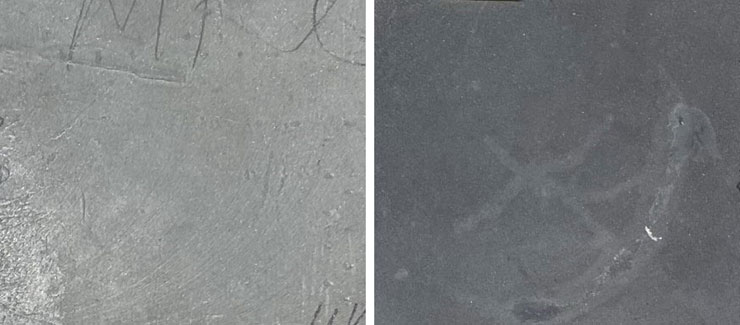 Composite materials No. 1 (left) and No. 2 (right), tested using heavy ion beams of the NICA Complex for future use as protection of spacecraft crews from cosmic radiation
Composite materials No. 1 (left) and No. 2 (right), tested using heavy ion beams of the NICA Complex for future use as protection of spacecraft crews from cosmic radiation
The material No. 2 is only 3 – 4 cm thick, which means it will not take up a lot of space of already cramped cabins. It is planned to be used at the Russian Orbital Service Station (ROSS) which should replace the ISS for Russian cosmonauts in the future, and at the manned transportation spacecrafts of a new generation. “It is important to study the properties of the protective material and make calculations on Earth. Now we are at the beginning of our journey”, the scientist continued. “Researchers from European and American space agencies are actively conducting studies to find the appropriate material for radiation protection in space. This is a painstaking process, and there is a general opinion that the magical material do not exist, each of them has its own advantages and disadvantages.” Although we should not ignore the possibility that there will be other modifications of innovative materials.
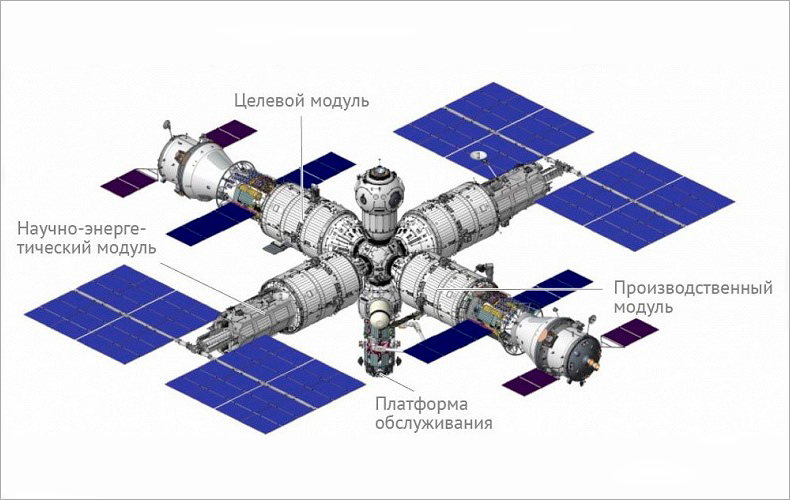 The final configuration of ROSS after 2030 (RSC Energia, source https://nplus1.ru/material/2021/04/26/ross)
The final configuration of ROSS after 2030 (RSC Energia, source https://nplus1.ru/material/2021/04/26/ross)
The experiment on irradiation of composites No. 1 and No. 2 on beams of heavy nuclei was carried out at NICA for several days. Based on the results of the experiment, a whole series of studies and tests is being prepared. At the moment the employees of the Department of Scientific and Methodological Research and Innovation at VBLHEP JINR are conducting activation analysis of the irradiated samples to determine the degree of activation of elements in the structure of the material under the influence of heavy nuclei beams. The evaluation of the structural changes of the two materials will also be carried out.
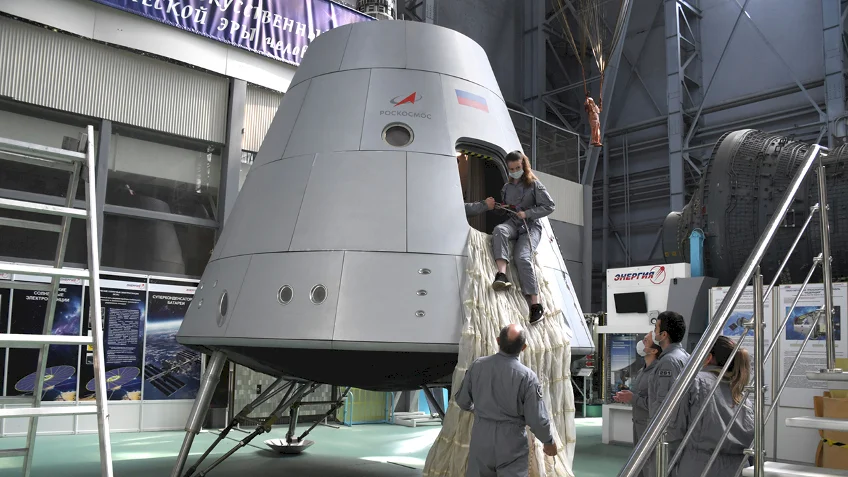 The prototype of the advanced manned transportation spacecraft “Eagle” being developed at the S. P. Korolev Rocket and Space Corporation Energia
The prototype of the advanced manned transportation spacecraft “Eagle” being developed at the S. P. Korolev Rocket and Space Corporation Energia
Irradiation of seeds
The IBMP RAS scientists will assess the germination of the seeds that have received their dose of ionising radiation at NICA, as well as evaluate their germination ability after irradiation, leaf size, and other parameters of development. Chromosomal aberrations will be studied using microscopy methods.
“Perhaps someday we will be able to grow plants on other planets. We are sending the seeds into space to evaluate whether it is possible to use them in the next missions. The seeds are more resistant to radiation than humans, because their structure is simpler. Nevertheless, changes occur in them. We will get unique results on xenon nuclei,” Vyacheslav Shurshakov said.
The ability of seeds to germinate in space conditions can be useful for the astronauts, they will be able to diversify their diet during long flights. The appearance of the greenhouses will also produce a positive psychological effect, as biological objects help the astronauts break the monotony of everyday life and cope with loneliness.
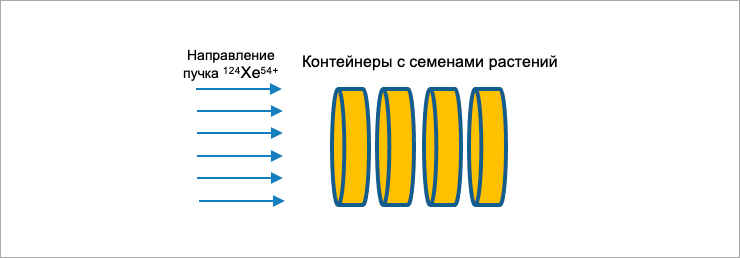 The scheme of irradiation of containers with plant seeds on a beam of 124Xe54+ ions of the NICA Complex with an energy of 3.8 GeV/nucleon
The scheme of irradiation of containers with plant seeds on a beam of 124Xe54+ ions of the NICA Complex with an energy of 3.8 GeV/nucleon
“Leading space agencies and the associated organizations are involved in the work with seeds. This is a classic area of research in the field of manned astronautics and life support issues in space. Such projects are constantly in the focus of attention of space agencies and organizations fulfilling their order,” Oleg Belov added.
Apart from the already implemented studies, IBMP RAS has big plans for the development of cooperation with JINR. In confirmation of these plans, the memorandum of mutual understanding between the ARIADNA Collaboration and the Institute of Biomedical Problems of RAS was signed on 11 January 2023.
Groundwork for the future
Russia plans to launch its own ROSS orbital space station in 2027 – 2028. The station will be built in a higher-latitude orbit than the ISS, and it will be possible to observe the entire territory of Russia from it, including the Northern Sea Route. Not a single space agency has ever had stations at such an altitude. However, there is an increased level of radiation in such an orbit. Because of this, a suggestion was made that astronauts visit the station rather than stay on it all the time. Vyacheslav Shurshakov said that IBMP is currently developing a special local protection for the human body. “Galactic radiation contains heavy nuclei, the passage of which through, for example, brain tissue may negatively affect cognitive functions with time, which is unacceptable for the extremely responsible work of astronauts during a space mission. We plan to create special protection for the head, as well as vests. We are thinking about the material and its thickness, about the best time for astronauts to wear the protection, for example, during sleep,” the scientist said. The gear elements of this kind will also have to be tested on beams of the NICA Complex in the future. In addition to local protections, new promising high-energy neutron dosimeters, which are currently being developed by scientists of the IMBP RAS, will be used at the ROSS station for the first time for space purposes. Their testing is also planned to be carried out at JINR. “Now we have regular dosimeters on the ISS board that help us monitor the radiation situation, but they do not measure the dose from neutrons. Neutrons have a very high biological effectiveness, and if we switch to a high-latitude station and plan flights to the Moon and beyond, we need such devices,” Vyacheslav Shurshakov explained.
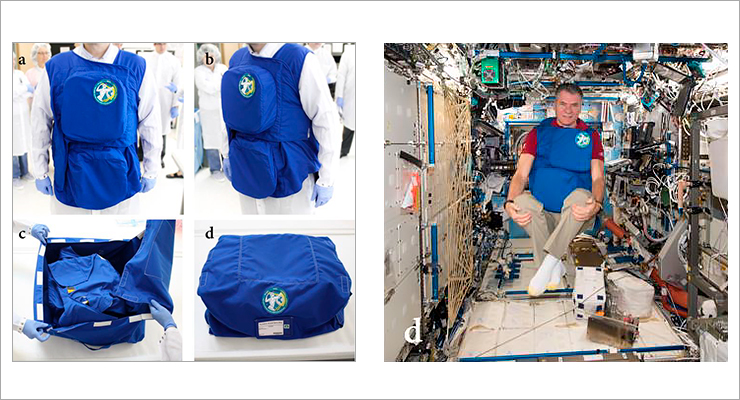 Use of local protection in the conditions of orbital flight: a prototype of the Italian water vest PERSEO [G. Baiocco, M. Giraudo, L. Bocchini, S. Barbieri, I. Locantore, E. Brussolo, D. Giacosa, L. Meucci, S. Steffenino, A. Ballario, B. Barresi, R. Barresi, M. Benassai, L. Ravagnolo, L. Narici, A. Rizzo, E. Carrubba, F. Carubia, G. Neri, M. Crisconio, S. Piccirillo, G. Valentini, S. Barbero, M. Giacci, C. Lobascio, A. Ottolenghi. A water-filled garment to protect astronauts during interplanetary missions tested on board the ISS, Life Sciences in Space Research, Volume 18, 2018, Pages 1-11, https://www.sciencedirect.com/science/article/pii/S2214552417301335#fig0004]
Use of local protection in the conditions of orbital flight: a prototype of the Italian water vest PERSEO [G. Baiocco, M. Giraudo, L. Bocchini, S. Barbieri, I. Locantore, E. Brussolo, D. Giacosa, L. Meucci, S. Steffenino, A. Ballario, B. Barresi, R. Barresi, M. Benassai, L. Ravagnolo, L. Narici, A. Rizzo, E. Carrubba, F. Carubia, G. Neri, M. Crisconio, S. Piccirillo, G. Valentini, S. Barbero, M. Giacci, C. Lobascio, A. Ottolenghi. A water-filled garment to protect astronauts during interplanetary missions tested on board the ISS, Life Sciences in Space Research, Volume 18, 2018, Pages 1-11, https://www.sciencedirect.com/science/article/pii/S2214552417301335#fig0004]
In the future, the capabilities of the NICA Complex will make it possible to obtain a so-called “combined” beam from several types of nuclei simultaneously, such as nitrogen, carbon, and iron in certain proportions, as was done, for example, at the Brookhaven National Laboratory in the USA. This will allow scientists to implement a more realistic approach to modelling cosmic radiation flows for testing detectors and materials for space purposes, as well as studying the biological effects of cosmic radiation.
IMBP RAS is a long–standing partner of JINR in the field of studying the biological effects of cosmic radiation in earthbound experiments using charged particle accelerators. The first ties between JINR and this scientific centre were established literally in the first decade since the founding of both organizations. In the early 60s, research was carried out at the DLNP JINR Synchrocyclotron. Even back then its task was to recreate radiation conditions in Earth orbit. In the 70s, a research building was put up on the JINR territory and the IMBP RAS laboratory was opened to study the radiobiological effects of exposure to heavy ions. In 2023, IMBP RAS celebrates its 60th anniversary. This year marks the beginning of a new stage of cooperation between the two institutes within the framework of the ARIADNA Collaboration at the NICA Complex on a number of joint works.
